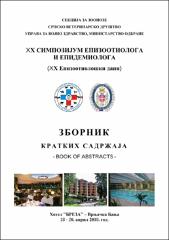Karakteristike encefalitisa kod labudova prirodno inficiranih virusom avijarne influence podtipa H5N8

View/
Date
2018Author
Božić (Đurđević), Biljana
Polaček, Vladimir
Vučićević, Ivana
Petrović, Tamaš
Samojlović, Milena
Pajić, Marko
Aleksić-Kovačević, Sanja
Metadata
Show full item recordAbstract
Some highly pathogenic avian influenza subtypes, such as H5N1 have significant tropism towards the nervous tissue. Neurotropism is a common characteristic of both experimental and natural infections caused by avian influenza virus subtype N5H1 in different bird species, and in some mammals including humans. During the epizootic of highly pathogenic avian influenza subtype H5N8 in Republic of Serbia, the highest morbidity and mortality rates were recorded in mute swans (Cygnus olor). In infected swans, the disease was clinically manifested in the form of difficult movement, rotation in circles, opisthotonus. Due to the appearance of nervous symptoms of the disease, brain samples of 15 swans were taken to determine the nature of the lesions in the brains of infected swans.
Macroscopic examination of the brains of infected swans revealed changes in the form of hyperemia and initiation of blood vessels of the brain and meninges. Pathohistological examination of heamotoxylin-eosin stained tissue cuts of cerebrum revealed changes in the form of non-purulent encephalitis with perivascular lymphocytic infiltration and hemorrhages in most of the examined swans. Frequent findings were the occurrence of neuronophagia and encephalomalacia. Massive haemorrhages were detected in cerebellum. Astrocitosis was detected by immunohistochemical staining of the brain tissue for glial fibrillary acidic protein (GFAP) in most of the examined swans. A polyclonal antibody to avian influenza virus nucleoprotein was used for the detection of viral antigen in the brain tissue. The influenza virus nucleoprotein is the most conserved and more expressed than other influenza virus proteins and for that reason is the most appropriate diagnostic target for antigen detection. Viral antigen was detected in neurons and glial cells of cerebrum. Immunopositivity was observed in the nucleus and cytoplasm of some Purkinje cells and glial cells of cerebellum.
Based on the above-described pathohistological lesions and multifocal distribution of the virus in cerebellum and cerebrum of naturally infected swans, we can conclude that influenza virus subtype N5H8 has high affinity for the nervous tissue in this bird species.
